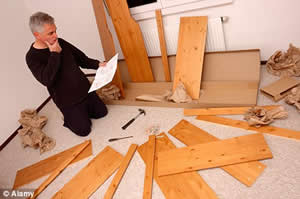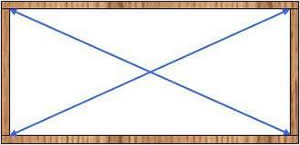
Figure 1 - Unassembled furniture
- If you have purchased more than one unassembled piece of furniture or cabinet; and if they are all from the same manufacturer choose the least complex piece to assemble first. The reason is that most manufacturers use a common method of assembly and common fittings. Choosing the least complex piece will allow you to educate yourself on the methods of assembly for that manufacture with the simplest piece of furniture or cabinetry.
- Open the box and make sure that there are no damages, specifically on the corners of the pieces, and ensure that you have all of the fittings – count each of the different fittings and compare it to the list of fittings supplied by most of the manufactures with their assembly information.
- Read the instructions and make sure you can identify each piece as per the assembly instructions. In many cases pieces may be very similar, an extra hole or some other small item may be the only difference and it may be possible to almost complete the assembly before you realize that you have reversed two pieces.
- Make sure you can identify each of the fittings. There may only be a 1/8 of an inch difference in length between two different screws and while the shorter one may work in the longer position the longer one will most likely not work in the shorter position.
- It is generally easier to assemble the furniture or cabinet on a hard surface floor rather than on a rug or carpeted floor. This is because the carpet or rug fibers have a tendency to get caught between the pieces that you are assembling. It is also easier to keep the unit square when it is assembled on a hard surfaced floor.
- Most unassembled furniture and cabinetry are made of MDF. Because of this the use of powered screwdrivers or electric drills with screwdriver bits is usually not a good idea. These types of tools have far too much torque and screws will strip very easily.
- In many cases, with unassembled furniture, such as a bookcase, cabinet or dresser, the only thing that keeps the unit square is the back panel assembly. The back panel of unassembled furniture or cabinetry is commonly made of pressed paper and has a fold in it and some may even have two or more folds.
Note: If you use a utility knife to open the box be careful that you do not scratch the surface of one of the panels with the tip of the utility knife as you cut the box open!
Note: It is not uncommon to have more fittings than required. As an example; the manufacture may have a common package of fittings that they supply with every bookcase no matter what size it is. You need all the fittings for the largest bookcase but only a portion of the fittings with smaller bookcases.
The back is usually the last item of the assembly process. Even if you have put the piece of furniture or cabinet together properly it is not necessarily square. It is very important that you verify that the piece of furniture or cabinet is square before you attach the back panel.
To square the piece of furniture or cabinet before you attach the back, place the assembled unit on its face on the floor and then measure the diagonals from corner to corner, as shown in Figure 2. The diagonal measurements must be identical!

Figure 2 - Measure diagonals
- Follow the manufacturers’ instructions with respect to sequence and other assembly information. Believe it or not, the manufacture does want you to be able to complete the assembly and be completely satisfied with their product.
- Lastly, take your time, think before you screw and/or nail sections together.
- Note: For added structural strength pieces can be glued as they are being assembled. Use yellow carpenters glue.
Note: It does not matter whether you measure the inside diagonal or the outside diagonal providing that you measure both diagonals from identical positions.
Note: If the piece of furniture or cabinet that you are assembling has drawers you should ensure that each drawer is perfectly square by measuring the diagonals in the same manner as you did for the basic frame of the piece of furniture or cabinet. Drawers that are not perfectly square will not close flush with the outside frame of the furniture or cabinet that you are assembling.
If the measurements are not identical shift one side of the piece of furniture, cabinet or drawer until the measurements match. You may be surprised at how much flex there is in the piece of furniture, cabinet or drawer prior to nailing on the back.
